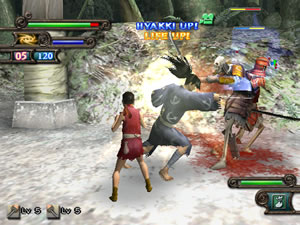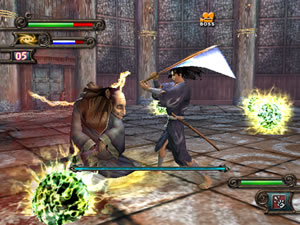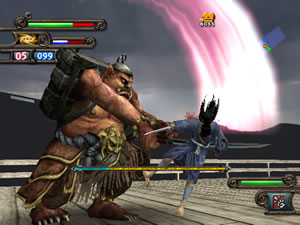We could use a transfusion.
We’ve seen many strange things over the years, but recently the oddities are
multiplying with more tenacity than rabbits popping Viagra. Dung
beetle simulators, magical
dating games, and now
Sega brings us our first paraplegic samurai warrior.
Yup, that’s right, the quirky, entertaining and hopelessly dated hack ‘n slash brawler Blood
Will Tell lets you play as a limbless swordsman. But while the character progression and leveling up add some spice, the bland gameplay leaves plenty to be desired.
What Blood
Will Tell does best is successfully immerse you in its surprisingly
engaging story, likely due to the fact that it’s adapted from the manga Dororo by
legendary manga storyteller Osamu
Tezuka (Astro
Boy). The game stars Hyakkimaru and his androgynous pal Dororo. Legend states
that a savior will come to end the suffering of Japan’s feudal period by vanquishing
the 48 Fiends, who secretly fuel the fires of dissent. So the Fiends, being
such, claimed 48 body parts from the chosen one, Hyakkimaru, upon his birth.
However, a doctor/mad scientist created wooden prosthetics
(which double as concealed weapons) for our hero, allowing him to pursue his
destiny, crush the Fiends and, most importantly, reclaim his stolen body parts.
As Hyakkimaru (and occasionally Dororo), you slice and dice your way through over 100 different enemy types, including the 48 Fiends and 60 demons. Along the way, you’ll
spend time cracking open every crate, box and barrel for hidden weapons and items
to increase your abilities and attack level.
Reclaiming your body parts from the 48 Fiends gives you additional powers or
awareness, which in turn affect the gameplay itself. When you find your left
eye, you’ll
be able to see in color. When you find your nose, detecting the stink of demons
becomes much easier, causing your controller to rumble when one is nearby.
It’s an
interesting, weird feature that gives the game its unique feel.
Your encounters with the Fiends are almost always in the form of end-level boss
battles. Some of the Fiends are not much bigger than you, while others are
towering monstrosities, ranging from nasty Tiamat
beasts to strange ghostly apparitions and ghastly multi-armed deities. Though
they can be quite imposing, pretty much every one can be beaten by learning
its patterns through trial and error. Skill takes a back seat to patience
and repetition.
 Justice is meted out mostly through your various combos. These are handled relatively well, with a good number of blade attacks for our hero’s swords and his peculiar sword arms, which he brandishes by casting off his wooden prosthetic forearms. Pretty nifty!
Justice is meted out mostly through your various combos. These are handled relatively well, with a good number of blade attacks for our hero’s swords and his peculiar sword arms, which he brandishes by casting off his wooden prosthetic forearms. Pretty nifty!
You’ll also do damage with a growing list of powerful ranged
Spirit Attacks. Your Spirit gauge is replenished as foes are dispatched,
and cracking open the many containers scattered throughout the game will occasionally
yield additional Spirit attacks. If your attack connects, you can deal even more
damage by quickly pressing the button sequence that conveniently appears on screen,
resulting in a huge combo for major damage. These are undoubtedly the best-looking
moves in the game, with great lighting and particle effects to pump up the brutality.
Rounding out Hyakkimaru’s offensive repertoire are his knee cannon and gattling
gun arm. These are stationary attacks aided by a floating cursor for aiming.
While not the most inspiring or balletic ordinance for a samurai, these ranged
attacks do come in handy.
And so does Hyakkimaru’s eventual sidekick, Dororo. The few levels that require you to play as him/her/it feature gameplay more suited to Dororo’s agility and thievery. This is also where the game suffers the most, with incessant platform jumping and a gross lack of action. Luckily, these levels are few and far between, but they will definitely make you second guess a second run once you’ve finished the game.
In a twist, a second player can play as Dororo during the levels where the CPU
would normally be at the helm. Sadly, this turns out to be just an afterthought
since the camera only follows Hyakkimaru, making a joke out any sort of functional
co-op feature. Dororo is much more useful under the computer’s command.
 Speaking of the camera, it could use a serious overhaul. You can rotate and snap the camera back to center, but the vantage point will occasionally shift, forcing you to rewire your brain as the controls may be reversed. Now forward is back, left is right, and so forth. Ugh!
Speaking of the camera, it could use a serious overhaul. You can rotate and snap the camera back to center, but the vantage point will occasionally shift, forcing you to rewire your brain as the controls may be reversed. Now forward is back, left is right, and so forth. Ugh!
Another less forgivable issue is the dated graphics engine. Blood
Will Tell looks more like a first-generation Sega Dreamcast game than one coming out at the tail end of the Playstation 2. Washed out graphics, rough edges, bad character models – it’s just not polished.
Nor is the A.I. Enemies are mindless and predictable, leading to Blood
Will Tell‘s biggest problem: boring repetition. Although the combos
are cool, there are simply not enough of them. The game lacks the style and verve
of greats like Devil
May Cry or Onimusha.
Ultimately, the dated feel, dumb enemies and repetitive gameplay leave you
wanting more.
The blood is decent and Osamu Tezuka tells a great story, but the will to play
just isn’t there.
-
Great story
-
Weird concept
-
Repetitive
-
Dated
-
Camera issues
-
Dororo is lame










